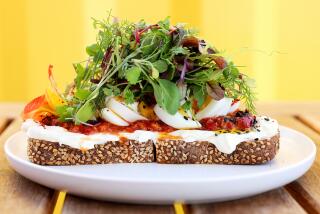San Diego Spotlight : Kaiserhof’s Hearty Cuisine Leads Pack in German Fare
- Share via
Not so terribly long ago, restaurants on the cutting edge made a point of serving plates garnished with one pristine, blushing carrot, an infant pea pod, a miniature turnip and a single specimen of the most impossibly slim and svelte asparagus.
This was all very trendy, very chic and very nouvelle , to give the name that characterized the vogue, but it wasn’t very filling. The question that always lingered: will hearty, savory cooking ever undergo a revival?
The deluge of new, look-alike but rather good Italian eateries that lately has rained down upon San Diego speaks well for the future of savory cooking. But for really hearty cooking it is now necessary to turn back the page and seek out German restaurants, which have dwindled in number locally to the point that, as a type, the German eatery perhaps should be placed on the endangered restaurants list.
The leader of this much diminished pack remains Kaiserhof, a lonely outpost of wursts and bratens in an improbable location at the far eastern tip of Mission Valley. Although it opened in the early 1980s, Kaiserhof has the comfortable feel of a place from 40 years earlier. The pianist in the tiny lounge sends Strauss (and polkas and old German drinking songs) waltzing around the dining rooms, and a general air of gemutlichkeit rises like a vapor above the steamy plates of boiled pork shanks and braised oxtails.
The no-nonsense waitresses, efficient rather than friendly, remind of times when servers served without joining the party. In five closely written pages--one of which is a typed list of the day’s many specials--the menu recites dozens of the classics of both German and generalized Middle European cooking.
Whatever new dishes chefs in Germany may be creating this very day, Kaiserhof takes no notice, nor need it do so, because traditional German cuisine is exactly what one wants when struck by the mood for truly savory fare. This menu opens with assorted cold plates and appetizers--pickled herring in various treatments naturally takes a place of honor--and marches along to robust goulash soup, a sufficient selection of seafood items (the sauteed shrimp in cream and Asbach brandy sounds interesting), fried veal sausage, smoked pork sausage and calves liver in Port sauce.
The above listings are sort of a warm-up for the more serious meat entrees. The German love for pork is expressed most profoundly by eisbein , or boiled fresh pork shank; other choices include a roasted shank, the ham-like smoked chops called Kasseler rippchen and the paprika schnitzel (the term here refers to pork rather than veal), a dish of cutlets finished in a rosy, paprika-spiced sour cream sauce. Although the sauce had much to recommend it, the meat itself was rather tough and chewy, and veal might indeed be a happier candidate for this treatment.
There are quite a number of veal offerings, of course, ranging from the basic Wiener schnitzel and the austere nature schnitzel (“natural” because the scallops are simply broiled) to the schnitzelette doused with tomatoes and Gruyere cheese and the veal imperial, the menu’s costliest item. It is forthright and not adventuresome, however, and is simply a sauteed veal steak topped with grilled ham and melted cheese.
If Greek restaurants are measured by their moussaka, German places inevitably rise and fall with the sauerbraten. Kaiserhof’s is good but not exceptional, the meat piquant from its long rest in a spiced marinade, the sauce smooth and rich but the texture of the beef a little dry and overcooked. The same comment could be made about the beef goulash, which again was more successful with the sauce than the meat.
The daily specials list may be the best page of the menu. This recently featured a ragout of braised oxtails, roast duck in Madeira sauce, New Zealand venison finished in a creamed green peppercorn sauce with German pfifferlinge (chanterelle mushrooms) and a pear filled with lingonberries, braised lamb shanks and--perhaps in response to the universal demand for pasta--a traditional Swabian preparation called maultaschen . The latter is a pasta filled with spiced chopped meat and spinach, plus an onion sauce.
The oxtails, piled in a large skillet filled to the brim with a dark brown sauce, boiled potatoes, braised carrots and mushroom caps, were really quite tasty and definitely off the current beaten track. It is important to remember that there is much in the way of bone to an oxtail, however, and that the meat is so rich and fatty that it leaves the lips glistening and slippery with grease.
The portions are immodest, which is to say, typical for American German restaurants. Even Kaiserhof has scaled back a bit from its early years, when meals included both soup and a salad of delightfully tart, freshly pickled cucumbers. Instead of both, now there is a choice between a most ordinary green salad and the soup of the day, recently a classy split pea flavored nicely with herbs and garnished with a few crisp croutons.
Most entrees also include the diner’s choice of two side dishes from a lengthy list that offers German fried potatoes, spaetzle (tiny dumpling-like noodles, virtually de rigueur with sauerbraten), potato pancakes, sauerkraut, red cabbage and, most tellingly, apple sauce. By and large, these tend to be first-rate.
* KAISERHOF: 5351 Adobe Falls Road, San Diego,287-3075. Lunch Tuesday-Saturday, dinner Tuesday-Sunday, closed Mondays. Entrees $10.25 to $19.25. Dinner for two, including a glass of wine each, tax and tip, about $35 to $65. Credit cards accepted
More to Read
Eat your way across L.A.
Get our weekly Tasting Notes newsletter for reviews, news and more.
You may occasionally receive promotional content from the Los Angeles Times.










